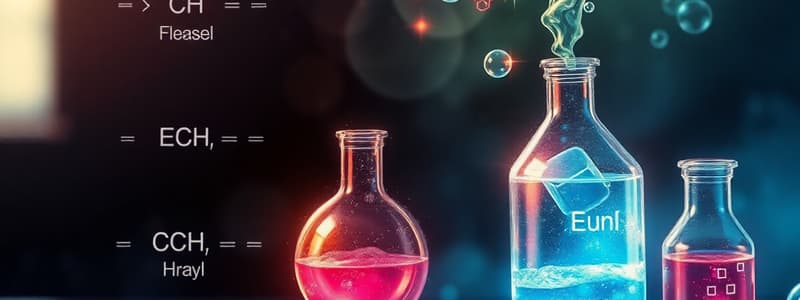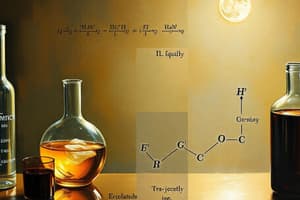Podcast
Questions and Answers
What evidence can indicate that a chemical reaction has occurred?
What evidence can indicate that a chemical reaction has occurred?
- Evaporation of a liquid
- Freezing of a substance
- Change in air pressure
- Color change (correct)
What is the main difference between a word equation and a skeleton equation?
What is the main difference between a word equation and a skeleton equation?
- Word equations lack details about the number of atoms involved. (correct)
- Skeleton equations include the products only.
- Word equations represent chemical formulas.
- Skeleton equations show reactants but not products.
Which process is an example of a physical change rather than a chemical change?
Which process is an example of a physical change rather than a chemical change?
- Burning wood
- Rusting iron
- Rotting food
- Boiling water (correct)
In a balanced chemical equation, what does the coefficient represent?
In a balanced chemical equation, what does the coefficient represent?
Which of the following equations uses chemical formulas to convey information about reactants and products?
Which of the following equations uses chemical formulas to convey information about reactants and products?
What do gas bubbles produced during a reaction typically indicate?
What do gas bubbles produced during a reaction typically indicate?
Which step must be taken after adjusting coefficients in a chemical equation?
Which step must be taken after adjusting coefficients in a chemical equation?
What is one reason why chemical equations must be balanced?
What is one reason why chemical equations must be balanced?
What occurs to particles during a chemical change?
What occurs to particles during a chemical change?
Which characteristic best describes substances in a solid state?
Which characteristic best describes substances in a solid state?
Which factor does NOT influence Brownian motion?
Which factor does NOT influence Brownian motion?
How is a molecular formula different from an empirical formula?
How is a molecular formula different from an empirical formula?
Which of the following is a sign of a chemical reaction?
Which of the following is a sign of a chemical reaction?
What is Brownian motion primarily the result of?
What is Brownian motion primarily the result of?
Which of the following statements is true regarding reactants and products?
Which of the following statements is true regarding reactants and products?
What effect does increasing temperature have on Brownian motion?
What effect does increasing temperature have on Brownian motion?
Study Notes
Evidence of a Chemical Reaction
- Temperature change can indicate a chemical reaction.
- Many reactions release energy as heat and light.
- Other reactions absorb heat.
- Color change can indicate a chemical reaction.
- Odor, gas bubbles, and the formation of a solid are also indicators of chemical change.
Representing Chemical Reactions
- Equations are used to represent chemical reactions.
- They show the reactants (starting substances) and products (substances formed).
Word Equations
- Express reactants and products in words.
- They lack information about the number of atoms involved.
Skeleton Equations
- Show symbols and formulas for reactants and products.
- They also lack information about the number of atoms involved.
Chemical Equations
- Use chemical formulas to show the identities and relative amounts of the substances involved in a chemical reaction.
Balancing Chemical Equations
- A coefficient is the number written in front of a reactant or product.
- Balancing ensures the Law of Conservation of Mass is obeyed.
Steps for Balancing Equations
- Write the skeleton equation for the reaction.
- Count the atoms of each element in the reactants.
- Count the atoms of each element in the products.
- Change the coefficients to make the number of each element equal on both sides of the equation. This shows that atoms are conserved.
- Write the coefficients in their lowest possible ratio.
- Check your work.
Chemical Reactions
- The process by which the atoms of one or more substances are rearranged to form different substances is called a chemical reaction.
- Another name for a chemical reaction is a chemical change.
Studying That Suits You
Use AI to generate personalized quizzes and flashcards to suit your learning preferences.
Related Documents
Description
This quiz covers key concepts related to evidence and representation of chemical reactions. It discusses indicators of chemical changes, including temperature and color changes, and explains different types of equations used to represent these reactions. Test your understanding of balancing chemical equations and terminology.




